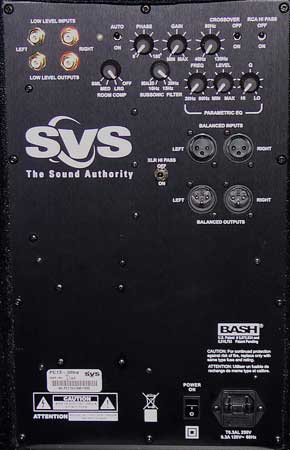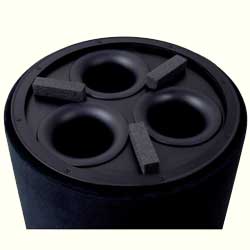Introduction
One of my favorite nerd-words is "disintermediation." It's a polite
economics term for "cutting out the middleman." A company manufactures
products and sells them directly to the customer, cutting out the
intermediaries in the supply chain and passing on the cost savings to
consumers.
In the home theater world, the Internet allows smaller A/V
manufacturers, who would otherwise never be able to afford large marketing
and advertising budgets, to develop a following among its customers and grow
beyond the geographic limitations imposed by brick-and-mortar companies.
That's disintermediation.
SVSound (formerly SVS) is a prime example of this model. Based in
Youngstown, Ohio, the eight-year old company has rapidly developed a
reputation for making high-quality subwoofers at consumer-friendly prices.
Its newest products, the
PB13-Ultra, and the subject of this review, the
cylindrical PC13-Ultra, incorporate a new 13" woofer and high-powered
BASH amplifier. Given SV Sound's track record, I expected superb performance
from the PC13-Ultra . . . and, I was not disappointed.
The Design
Back in the day, SVSound's subwoofers looked nothing like the squat
boxes that now dominate the market, but instead resembled large
cylindrical-shaped towers. The reasons for this tubular design were based on
solid engineering principles and practical considerations. Round speaker
enclosures are generally stronger than a box of similar size, and lack
corners that create uneven cabinet pressures and distortion. As a result, a
cylinder shaped subwoofer will weigh less than a similarly sized box design.
Plus, a cylindrical subwoofer will make a smaller footprint than a box
subwoofer of equal volume, so it uses up less of your floor space. I suspect
that the main reason companies went to the box-shaped design was the dreaded SAF (Spousal
Acceptance Factor), and indeed, SVSound now makes box subwoofers
to please the entire household.
 While the basic design of cylinder subs haven't changed, the components have
evolved over time. SVSound designs and builds its own speakers, in this
case a 13.5" stitched foam-core/glass composite cone housed in a
die-cast aluminum frame. The top of the cylinder sports three 3.5"
flared ports, which when plugged, change the tuning and allowing deeper
frequency response (more on that below).
While the basic design of cylinder subs haven't changed, the components have
evolved over time. SVSound designs and builds its own speakers, in this
case a 13.5" stitched foam-core/glass composite cone housed in a
die-cast aluminum frame. The top of the cylinder sports three 3.5"
flared ports, which when plugged, change the tuning and allowing deeper
frequency response (more on that below).
The PC13-Ultra is powered by a flush-mounted BASH amplifier capable of 750
watts RMS. The back panel is packed with useful features and options
typically found only in subwoofers costing several times the SVSound's $1,399
list price.
Connections include two inputs each (left and right) for both
RCA and balanced XLR signals, plus matching outputs for easy daisy-chaining
of multiple subs if you're so inclined. Phase control is adjustable from 0
to 180 degrees, and the defeatable internal crossover is adjustable from 40
– 120 Hz.
Advanced features include a room size compensation adjustment (set for
small, medium, or large rooms), and a single band parametric EQ that can be
set anywhere from 20-80 Hz, along with the level and adjustable Q
(the spread of the EQ band).
 Finally, there is a four-way subsonic filter, with settings at 20 Hz, 15 Hz,
10 Hz, or Sealed configurations. This setting is used in conjunction with
the three ports housed under an easily removable grille at the top of the
cylinder. When all three ports are open, the PC13-Ultra is tuned to 20 Hz.
Plugging one port changes the tuning to 15 Hz, two ports results in a 10 Hz
tuning, and plugging all three ports emulates a sealed configuration. As our
bench testing showed, these settings were not merely window dressing, but
had a noticeable effect on the PC13-Ultra's frequency response.
Finally, there is a four-way subsonic filter, with settings at 20 Hz, 15 Hz,
10 Hz, or Sealed configurations. This setting is used in conjunction with
the three ports housed under an easily removable grille at the top of the
cylinder. When all three ports are open, the PC13-Ultra is tuned to 20 Hz.
Plugging one port changes the tuning to 15 Hz, two ports results in a 10 Hz
tuning, and plugging all three ports emulates a sealed configuration. As our
bench testing showed, these settings were not merely window dressing, but
had a noticeable effect on the PC13-Ultra's frequency response.
The Sound
I tuned the PC13-Ultra to 20 Hz mode for listening purposes, with all three
ports open. Music, both CD and hi-rez, were played through the Oppo DV-980H
via HDMI into an Integra DTR-7.8 THX Ultra2 receiver. Movies were played
through a Toshiba HD-A2 HD DVD player into the Integra.
So as to not mince words, the PC13-Ultra knocked me on my tail. We're talking
wall shaking, glass-rattling, floor-rumbling bass. The title track of the
Eagles Hotel California (DVD-Audio) puts the kick drum way out front in the
mix, and is EQ'ed with a fat low-end. The SV sub pushed so much air in
reproducing the kick drum that it felt like I was sitting in front of a pile
driver.
Nonetheless, the PC13-Ultra was very capable of being musical in its sound
reproduction. Describing a subwoofer as being "fast" may drive some people
batty, leading to technical discussions of damping factors, distortion at
harmonic frequencies, and so on. But as a bass player who's played through
many different amps and PA systems, I know that hitting staccato
eighth-notes requires a system that will allow the listener to hear (and
feel) each distinct note, rather than have them blend into a droning buzz.
Paul McCartney's "Silly Love Songs" (from his All The Best CD - mock the song at
your own risk) has a great walking bass line, and the SV let me enjoy each
note being picked by Sir Paul.
But the real action was in movies. 300 (HD DVD) has a sprinkling of dialogue
("This is Sparta!"), but mostly consists of outrageous fight sequences,
complete with charging rhinos and hordes of invaders so numerous that the
ground shakes like an earthquake. The PC13-Ultra was up to the task, at
times pressurizing the entire room with low frequency energy.
Shooter (HD DVD) has plenty of gunfire, and several fantastic explosions;
especially at the end of the film when a mountain cabin filled with propane
blows apart in a fireball. The PC13-Ultra made me feel like the cabin was
really exploding in front of me; all that was missing was the heat blast.
Go to Part II.